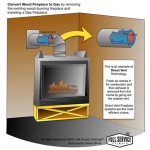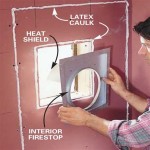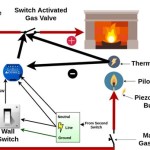DIY Outdoor Wood Burning Fireplace Kits: A Comprehensive Guide
The allure of a crackling fire under the open sky is undeniable. An outdoor wood-burning fireplace provides both warmth and ambiance, transforming a backyard into a welcoming haven for relaxation and social gatherings. Building a fireplace from scratch can be a daunting task, requiring significant construction knowledge and specialized tools. This is where DIY outdoor wood-burning fireplace kits shine, offering a streamlined approach to achieving a custom-looking fireplace with pre-fabricated components and relatively straightforward assembly.
These kits cater to a range of skill levels and design preferences, enabling homeowners to enhance their outdoor living spaces without the extensive labor and potential errors associated with traditional construction. They typically include the core components necessary for building a functional firebox and chimney, leaving room for customization with exterior finishes and surrounding landscaping.
Understanding the Benefits of DIY Fireplace Kits
Opting for a DIY outdoor wood-burning fireplace kit offers several distinct advantages over either building from scratch or hiring a professional contractor. The primary benefits center around cost savings, convenience, and the opportunity for personalization.
Cost-Effectiveness: The most compelling reason to consider a DIY kit is the potential cost savings. By purchasing pre-designed and pre-cut components, homeowners avoid the expense of hiring masons, bricklayers, and other skilled laborers. Furthermore, the bulk purchase of materials included in the kit often results in a lower overall cost compared to sourcing individual materials from various suppliers. This allows for a more budget-friendly approach to adding a desirable feature to an outdoor living space.
Simplified Construction: Unlike building a fireplace from the ground up, a kit comes with detailed instructions and pre-fabricated components. This significantly reduces the complexity of the project, making it accessible to individuals with moderate DIY skills. The pre-cut pieces minimize the need for precise measurements and intricate cutting, saving time and reducing the risk of errors. Even for those with limited construction experience, the step-by-step guide can provide a clear roadmap for successful completion.
Customization Options: While the core fireplace structure is provided by the kit, homeowners retain considerable freedom to personalize the finished product. The exterior can be clad with a variety of materials, such as brick, stone, stucco, or tile, to complement the surrounding landscape and architectural style. Accessories such as mantels, hearth extensions, and seating walls can also be added to create a unique and inviting outdoor focal point. This balance between pre-fabrication and customization allows for a personalized aesthetic without the complexities of total custom design.
Key Considerations When Choosing a Fireplace Kit
Selecting the right DIY outdoor wood-burning fireplace kit requires careful consideration of several factors, including size, materials, style, local regulations, and skill level. Making informed decisions during the selection process will ensure a successful and satisfying project.
Size and Placement: The size of the fireplace should be proportionate to the available space and the intended use. A large fireplace may overwhelm a small patio, while a small fireplace may not provide sufficient warmth for a large gathering. Carefully measure the intended location and consider the proximity to structures, trees, and property lines. Local building codes often dictate specific setback requirements to minimize fire hazards. Also consider prevailing wind direction to minimize smoke nuisance to neighbors.
Materials and Durability: The materials used in the fireplace kit should be durable, weather-resistant, and capable of withstanding high temperatures. Common materials include firebrick, concrete blocks, and refractory mortar. Firebrick is essential for lining the firebox to protect the surrounding structure from the intense heat of the fire. Refractory mortar is specifically designed to withstand high temperatures and prevent cracks in the joints. Consider the climate and choose materials that are appropriate for the local weather conditions.
Style and Design: Fireplace kits are available in a wide range of styles, from traditional to contemporary. Choose a style that complements the existing architectural design of the house and surrounding landscape. Consider the shape of the firebox, the height of the chimney, and the overall aesthetic of the finished product. Some kits offer a more rustic appearance, while others have a sleek and modern design. Consider how the fireplace will integrate with the overall outdoor living space and choose a style that enhances the ambiance.
Local Regulations and Permits: Before purchasing a fireplace kit, it is imperative to check local building codes and regulations. Many jurisdictions require permits for outdoor fireplaces, and there may be restrictions on the type of fuel that can be burned, the size of the firebox, and the height of the chimney. Failure to comply with local regulations can result in fines or the need to dismantle the fireplace. Contact the local building department to obtain the necessary permits and ensure that the project meets all applicable requirements.
Skill Level and Tools: Assess your own DIY skills and experience before undertaking the project. While fireplace kits are designed to simplify the construction process, some kits may require more advanced skills than others. Read the instructions carefully and make sure you have the necessary tools and equipment. Essential tools may include a level, a trowel, a concrete mixer (depending on the kit), a circular saw, a drill, and safety gear such as gloves and eye protection. If you are unsure about any aspect of the project, consider seeking assistance from a qualified contractor or experienced DIYer.
The Construction Process: A Step-by-Step Overview
The construction process for DIY outdoor wood-burning fireplace kits generally follows a similar sequence, although the specific steps may vary depending on the kit's design and complexity. A thorough understanding of the process is crucial for a successful outcome.
Foundation Preparation: The first step is to prepare a solid and level foundation for the fireplace. This may involve excavating the ground, pouring a concrete slab, or building a raised platform. The foundation must be strong enough to support the weight of the fireplace and prevent it from settling or shifting over time. Ensure the foundation extends beyond the footprint of the fireplace to provide a stable base. Accurate leveling is essential to ensure the fireplace is structurally sound and aesthetically pleasing.
Firebox Assembly: The firebox is the heart of the fireplace and is typically constructed from firebrick and refractory mortar. The firebrick is arranged in a specific pattern to create a heat-resistant chamber for the fire. The refractory mortar is used to bind the bricks together and seal the joints. Follow the instructions carefully to ensure the firebox is properly constructed and that all joints are sealed to prevent smoke leakage. Precise application of the mortar is crucial for creating a durable and fire-resistant firebox.
Chimney Construction: The chimney is responsible for drawing smoke away from the fire and directing it into the atmosphere. It can be constructed from a variety of materials, including concrete blocks, brick, or metal flue liners. The chimney must be properly sized to ensure adequate draft and prevent backdrafting. Follow the instructions carefully to ensure the chimney is properly constructed and that all joints are sealed. The chimney needs to extend high enough above the surrounding structures to ensure proper smoke dispersal. Local building codes often dictate the minimum height requirements for chimneys.
Exterior Finishing: Once the core structure of the fireplace is complete, the exterior can be finished with a variety of materials, such as brick, stone, stucco, or tile. The exterior finishing not only enhances the aesthetic appeal of the fireplace but also provides additional insulation and protection from the elements. Choose a finishing material that complements the surrounding landscape and architectural style. Proper installation of the exterior finish is crucial for preventing water damage and maintaining the longevity of the fireplace.
Safety Considerations: Throughout the entire construction process, prioritize safety. Wear appropriate safety gear, such as gloves, eye protection, and a dust mask. Be careful when lifting heavy materials and follow all safety instructions provided with the kit. Ensure that the fireplace is properly vented and that there are no flammable materials in close proximity. Regularly inspect the fireplace for cracks or damage and make any necessary repairs promptly. A properly constructed and maintained fireplace will provide years of enjoyment while minimizing the risk of fire hazards.
Choosing the right DIY outdoor wood-burning fireplace kit, understanding the construction process, and adhering to safety guidelines are crucial for creating a beautiful and functional outdoor feature. With careful planning and execution, a DIY fireplace can transform an outdoor living space into a cozy and inviting retreat.

Diy Outdoor Fireplace Kit Fremont Makes Hardscaping And Easy

Semplice Outdoor Fireplace Kit Rcp Block Brick

Diy Outdoor Fireplace Kit Fremont Makes Hardscaping And Easy

Diy Outdoor Fireplace Kit Fremont Makes Hardscaping And Easy

Semplice Outdoor Fireplace Kit Rcp Block Brick

Stone Age Manufacturing 18 Inch Veranda Diy Outdoor Fireplace Kit

Outdoor Fireplace Kits Stonewood S Cape Cod Ma Nh Ct

Outdoor Fireplaces Diy Kits Plans Cape Cod Ma Ri

Mason Lite Indoor Outdoor Wood Burning Fireplace Kit Patio Furnishings

Diy Outdoor Fireplace Ideas
Related Posts








